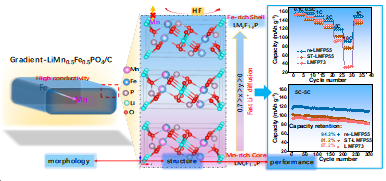Recently, Professor Yong Liu's research team at the College of Materials Science and Engineering, Beijing University of Chemical Technology, published a research paper titled 《Enabling High Rates Capacity and Cyclability of LiMn0.5Fe0.5PO4 Cathode Material through Gradient Core-Shell Structuring》. The study proposed and successfully prepared a Mn-rich/Fe-rich core-shell structured LiMn0.5Fe0.5PO4 (LMFP) material via a simple solvothermal method. The Fe-rich gradient surface layer not only stabilizes the interfacial chemistry and achieves more efficient carbon coating but also significantly enhances the reversibility and speed of the phase transition within the Mn-rich LMFP core during lithiation/delithiation. Consequently, the material achieves a balance of higher specific energy and high-rate performance.

LiMnyFe1-yPO4 cathode materials have emerged as candidates for next-generation lithium-ion batteries due to their safety, cost-effectiveness, environmental friendliness, and particularly high energy density. However, inherent drawbacks such as low conductivity, Mn3+ dissolution, and defect generation induced by lattice distortion resulting from the Jahn-Teller effect severely limit their application potential.
This study demonstrates a scalable solvothermal method for efficiently preparing high-performance gradient LiMn0.5Fe0.5PO4. This involves a short solvothermal reaction (2 h) using precursor solutions of LiMn0.7Fe0.3PO4 and LiFePO4. The resulting material features an internal Mn-rich core primarily composed of LiMn0.7-xFe0.3+xPO4(0<x<0.2) and a Fe-rich surface shell. Research indicates that the Fe-rich surface layer provides stable surface chemistry, including reduced side reactions and Mn3+ dissolution, while also facilitating the formation of a highly conductive carbon coating. The re-LMFP55 material exhibits a broader solid-solution phase transition region during charge/discharge cycles, with highly reversible phase transitions. Consequently, it achieves a balance of high specific energy and high-rate performance. The structure design for high-performance LMFP proposed in this work optimally combines the advantages of different phosphate cathode materials. It reveals a new pathway for understanding the influence of transition metals on the carbonization process and regulating lattice strain, showing promise for advancing phosphate-based high-energy-density cathode materials and their batteries.
Shuzhen Li is the first author of this work, a doctoral candidate at the College of Materials Science and Engineering, Beijing University of Chemical Technology (BUCT). The corresponding authors are Professor Yong Liu (BUCT), Professor Xiangming He (Tsinghua University), and Professor Li Wang (Tsinghua University). BUCT is the primary affiliation.
Original paper link: https://doi.org/10.1016/j.ensm.2025.104377


